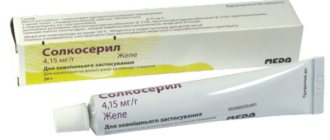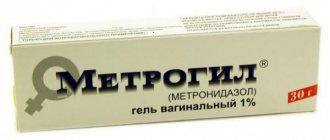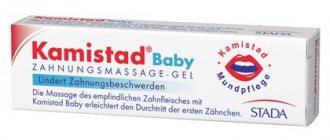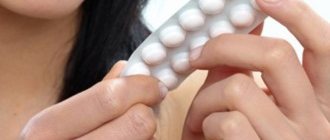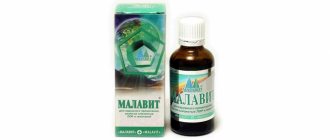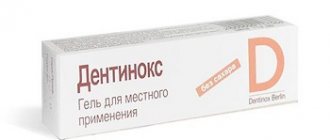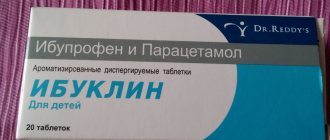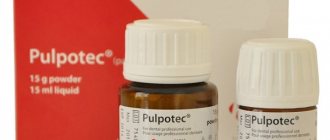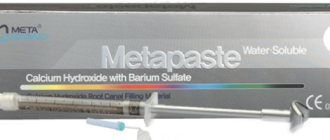"Levomekol" is an antibacterial combination drug for external use with a wide spectrum of action. Levomekol ointment prevents the spread of pathogenic microbes, eliminates swelling, accelerates wound healing, and also increases local skin immunity.
Levomekol for burns
This combination is provided by two active components in the ointment - Chloramphenicol (aka Levomycetin) and Methyluracil. Chloramphenicol is a natural antibiotic that actively blocks intestinal, pseudomonas and staphylococcal bacilli. And methyluracil accelerates the regeneration of the epidermis. The peculiarity of methyluracil is its ability to easily and quickly penetrate into the dermis, without affecting the membrane cell membrane. This process is associated with the removal of excess fluid from the intercellular space, which usually causes swelling and bruising.
What is Levomekol used for?
Levomekol has a multifaceted therapeutic effect:
- quickly reduces the inflammatory process, prevents its spread to healthy tissues;
- prevents the growth and reproduction of bacterial infectious agents;
- quickly eliminates swelling by normalizing microcirculation;
- ensures delivery of nutrients and biologically active substances, as well as molecular oxygen, to the affected tissues;
- stimulates the regeneration of inflammatory cells of all layers of the epidermis;
- increases immunity at the local level.
The ointment quickly removes all inflammatory processes on the skin
It is worth noting that the presence of purulent discharge and necrotic tissue does not prevent Levomekol ointment from performing its function. The drug can be used to disinfect and accelerate tissue regeneration.
Levomekol, ointment for external use, 40 g, 1 pc.
STADA, Russia
Price from 126₽
There are contraindications. Specialist consultation is required.
Indications for use of Levomekol ointment
Since Levomekol ointment has an antibacterial effect, and at the same time stimulates the restoration of tissue structure, the drug is indicated for the following diseases:
- infection of wounds with pathogenic microflora, ulcers and purulent abscesses on the epidermis;
- burns (mostly 2nd and 3rd degree);
- violation of tissue integrity due to injuries;
- necrotic processes;
- weeping and dry eczema;
- calluses;
- trophic ulcers;
- frostbite of the extremities (superficial layers of the skin);
- pimples, acne, carbuncles, boils;
- otitis and sinusitis (including with purulent discharge);
- treatment of sutures after surgery
- bedsores;
- haemorrhoids.
Levomekol ointment can be used for children
"Levomekol" can be used for children from 1 year. But before this, it is imperative to consult a pediatrician.
Contraindications
Like many drugs, Levomekol has contraindications:
- individual intolerance to the components of the medication;
- hypersensitivity of the body;
- fungal infections of the epidermis;
- tendency to allergic reactions;
- psoriasis.
The official instructions for use indicate that in pediatrics the ointment is prescribed starting from 3 years of age. However, many pediatricians, based on the harmlessness of Levomekol, allow its use from infancy.
Contraindications and side effects
"Lincomycin" and its analogues are quickly absorbed from the gastrointestinal tract and after a couple of hours are found in all tissues and environments of the body, including breast milk and bones. Therefore, lincosamides are contraindicated in diseases of the gastrointestinal tract, liver and kidneys, pregnancy and lactation, as well as in case of individual intolerance.
The following side effects are possible when using these drugs:
- abdominal pain, nausea;
- allergic reactions, rash, itching, Quincke's edema;
- fever, sore throat;
- candidiasis;
- blood clotting disorder.
Side effects
Levomekol is considered a universal drug and is usually well tolerated by patients. But in case of overdose (if the drug is used for more than a week), allergic skin reactions may occur.
- hyperemia;
- burning;
- itching;
- urticaria;
- dermatitis at the site of application;
- local swelling;
- When using vaginal tampons, candidiasis may occur.
No incompatibility with other medicinal products has been reported. Make sure that the ointment does not get into your eyes, mucous membranes or inside. In case of contact with eyes and mucous membranes, rinse them immediately with running water. If swallowed, the stomach must be rinsed.
Levomekol in the treatment of burns
For burns, Levomekol is needed to prevent infection of the wound surface with pathogenic infections, as well as to accelerate tissue healing. Levomekol also copes with inflammation, which can lead to suppuration of the wound. The ointment cleanses the affected area well from both purulent discharge and necrotic cells.
The treatment system for a small area burn of 1-2 degrees is as follows:
- before applying the ointment, the wound is washed under running water;
- the ointment is applied to a sterile gauze pad, which is applied to the wound surface;
- the bandage is applied for a day;
- dressings are done every day - up to 5 times a day.
The burn is treated until the tissue is completely healed. The total duration of the course for minor household burns is 5 – 14 days.
Levomekol in the treatment of acne
"Levomekol" has an antibacterial and wound-healing effect, therefore it is widely used in dermatology, in particular, in the treatment of acne. The course of treatment depends on the severity of the disease and the number of skin rashes.
Small pimples are treated by applying a thin layer of ointment to the affected area. This is done in the evening for several hours, and before bedtime Levomekol is washed off. Within two weeks, pimples disappear, facial skin becomes even, and small scars heal.
Treating acne with ointment
Levomekol is applied to isolated inflamed pimples in a thin layer, covered with a small piece of cotton wool and left for 2-3 hours. Therapy lasts 2-3 days.
As for opened pimples, the medicine is placed directly into the resulting holes.
To treat acne, Levomekol is applied to the affected area overnight. In the morning, the ointment must be washed off. Typically, the course of treatment takes 2 weeks, during which the inflammation subsides and the acne breaks out or resolves.
To eliminate subcutaneous acne, you need to do the following:
- after washing with soap, the skin is cleansed with any tonic or lotion;
- Apply the ointment in a thin layer on a sterile napkin and apply it to the area of skin with acne;
- the bandage is fixed with adhesive tape.
The duration of the treatment procedure is 3-5 hours. If deep, painful ulcers appear on the skin, keep the bandage on the body all night.
The duration of therapy is about 7-10 days, depending on the degree of damage to the dermis.
"Lincomycin": instructions for use
Analogs of the drug have the same composition and mode of action. They can be purchased under several names: “Lincomycin”, “Lincomycin hydrochloride”, “Tsilimicin”, “Neloren”, “Medoglycin”, “Linosin”, “Lincocin”. All of these drugs are equally effective against gram-positive bacteria. They are especially often used against streptococci, which are resistant to other antibiotics.
These drugs are available in tablets or capsules, most often 500 mg. They should be taken several hours before meals, since any food greatly reduces the effectiveness of the action. Usually the medication is prescribed 3-4 times. The duration of treatment is 1-2 weeks. But for complex infections of the skin, soft tissues and skeletal system, it can be extended to 3 weeks. After all, resistance of microorganisms to Lincomycin, if developed, occurs very slowly.
Levomekol in the treatment of hemorrhoids
Levomekol ointment can be used as an addition to complex therapy for hemorrhoids during periods of exacerbation. It is recommended to use the ointment in cases where blood is released from the hemorrhoids. Since the drug has an antibacterial effect (wounds can be infected with feces), helps relieve inflammation and neutralize pathogenic bacteria, Levomekol is prescribed for the regeneration of anal tissue.
- it is necessary to wash the perineum and anus with soap and water and dry with a soft towel;
- apply a thin layer of ointment to the anus before going to bed;
- the area of influence from above is covered with a bandage and fixed with an adhesive plaster;
- When treating internal nodes, a tampon is soaked in ointment, which is then inserted into the anus.
Levomekol for hemorrhoids
The duration of therapy is 10 days. Since Levomekol is not a specialized antihemorrhoidal drug, after the inflammation has resolved, the decision to continue therapy and prescribe medications is made only by the attending physician.
Lincomycin analogues
Ceftriaxone
Ceftriaxone is the most common cephalosporin. It is an antibiotic with a wide spectrum of bactericidal effect against gram-positive and gram-negative bacteria. The mechanism of action of the drug is its ability to disrupt the integrity of the cell membrane of microbes, which leads to their lysis.
Unlike lincomycin, ceftriaxone is considered safe for pregnant women and newborns. It is used exclusively in the form for intramuscular or intravenous administration. Among the main indications for prescribing the drug are bacterial pathologies of soft tissues, abdominal cavity, lungs (pneumonia), respiratory tract and digestive system. Ceftriaxone also passes well through the blood-brain barrier, which allows it to be used for meningitis.
The main contraindication for prescribing ceftriaxone is the presence of hypersensitivity to beta-lactam drugs (penicillins, cephalosporins, monobactams, carbapenems).
Also, this drug should not be used if the kidneys have insufficiency and their filtration function is impaired.
Among the side effects of ceftriaxone, it is necessary to highlight allergic reactions of various forms and severity - rash, redness in the injection area, Quincke's edema, anaphylactic shock. Functional disorders of the digestive tract, the addition of a secondary bacterial infection, a transient increase in liver enzymes and headaches with dizziness are also possible.
Doxycycline
Doxycycline is a drug from the tetracyclic series. It is characterized by a bacteriostatic effect - antibiotic molecules pass inside the microbial cell, where they inhibit the ribosomal subunit and stop protein synthesis in it. Doxycycline acts against streptococci, staphylococci, pneumococci, meningococci, gonococci, Shigella, salmonella, enterobacteria and other pathogens.
A feature of doxycycline, like other tetracyclines, is the ability to bind to calcium salts, which significantly increases the specificity of the drug to bone and dental tissue. Its bioavailability for oral administration is about 100%, so this drug is widely used in tablet form.
Doxycycline is prescribed for bacterial inflammation of soft tissues, bones, as well as for a number of specific infectious pathologies (such as typhoid, brucellosis, tularemia, cholera). This antibiotic has also found its use in dentistry.
The following side effects are found with doxycycline:
- hypersensitivity reactions;
- digestive system disorders;
- blurred vision, headache, dizziness, increased intracranial pressure;
- inhibition of hematopoiesis;
- violation of the formation of the skeleton and tooth enamel;
- increased sensitivity to sunlight;
- pain in joints and muscles;
- increased liver enzymes.
The drug is not recommended for use during pregnancy, lactation and in children under 5 years of age.
Contraindications also include porphyria and uncompensated liver diseases.
- Lincomycin - indications for use and contraindications;
- See here - Vancomycin: analogues and instructions for their use;
- Doxycycline - analogues and their brief description: https://med-antibiotiks.com/analogi/analogi-preparata-doksiciklin-svojstva-i-pokazaniya-k-primeneniyu/.
Clarithromycin
Clarithromycin belongs to the macrolide group of antibacterial agents. The drug is capable, like most bacteriostatic drugs, of blocking the 50S ribosomal subunit, which makes it impossible for the microorganism to further reproduce. Clarithromycin molecules are able to accumulate in foci of the inflammatory process, where they can remain for up to 72 hours. This is due to the long potentiating effect of the drug.
Clarithromycin acts against staphylococci, streptococci, Haemophilus influenzae, Listeria, Neisseria, mycobacteria, mycoplasma, chlamydia and toxoplasma. The antibiotic is produced exclusively in tablet form.
Among the indications for prescribing clarithromycin tablets are inflammatory processes of soft tissues, respiratory tracts, ENT organs and the genitourinary system. The antibiotic is produced exclusively in the form of tablets or syrup for children.
Among the side effects, it is necessary to note the addition of a secondary infection, the development of allergic reactions, cases of cardiac tachyarrhythmias, disorders of the digestive system, renal failure, increased liver enzymes in the blood and dizziness.
The main contraindication to the use of clarithromycin is the patient's hypersensitivity to macrolides.
Levomekol in the treatment of wounds
Levomekol helps heal damaged tissue and prevents infection of the wound surface. Moreover, it is not so important whether the wound has festered or not. If the wound is not purulent, then first the affected area is treated with an antiseptic. The ointment is applied in a thin layer overnight, then it must be covered with a sterile gauze cloth and secured with a bandage. Most often, wound treatment is required once a day.
If the wound festers, then using cotton-gauze swabs moistened with an antiseptic, the pus and secreted secretions are removed. Then Levomekol ointment is applied to the wound - it should be completely filled, but not too tightly. The affected area is covered with a gauze cloth, also soaked in ointment. As for the frequency of changing the bandage, it all depends on the amount of pus released. Usually a double dressing is sufficient.
And if the wound is deep and accompanied by an infectious lesion, then Levomekol is preheated to 35 degrees Celsius, then a sterile napkin is soaked in ointment (several can be used if the affected area is large) and injected into the lesion. If the affected area is large, use several napkins with Levomekol. It is important that the wound is filled completely, but not too tightly.
Note that to administer the medication into puncture and deep wounds, it is better to use a rubber drainage tube, and inject the heated ointment itself using a syringe.
The duration of therapy usually lasts from 5 to 10 days.
Reviews on the use of lincosamides
Lincomycin has been popular for many years. Its analogues are also known and also widespread. Low cost - about 40-50 rubles, effectiveness against severe infections and a small number of contraindications often make lincosamides the drugs of choice for treatment. There are especially many positive reviews about the use of Lincomycin and its analogues after tooth extraction. Patients note that the wound quickly healed and there was no inflammation. This drug effectively prevents infection after fractures and soft tissue damage.
There are also negative reviews about taking lincosamides. The most commonly noted side effects are diarrhea, abdominal pain, and allergic rashes. But mostly this happens due to individual intolerance. To prevent this, you need to take medications that normalize the intestinal microflora along with taking the antibiotic.
Use of Levomekol ointment in gynecology
Levomekol is successfully used in gynecology and urology.
In gynecology, therapy is carried out using tampons with ointment applied to them. A similar method is indicated for the treatment of the following conditions:
- inflammatory erosion of the cervix;
- inflammation of the uterine appendages (ovaries, fallopian tubes);
- divergence of vaginal sutures after ruptures during childbirth or operations.
The treatment system consists of the following sequence of actions:
- before use, a woman must thoroughly wash and dry the skin of the treatment area and perineum;
- if therapy is used after the divergence of vaginal sutures or after operations, then the sutures must be treated with a weak solution of potassium permanganate or furatsilin;
- you need to make a small cotton swab, put an ointment on top of it measuring 15 mm x 15 mm, and 5 mm high;
- insert into the vagina at night and remove in the morning;
- if therapy is used after the divergence of vaginal sutures or after operations, then the ointment is applied to a gauze bandage and applied to the sutures. Then put on clean underwear (if necessary, you can additionally use a pad). The dressing remains on for 2 to 6 hours.
Using the method described above, the active substance of the ointment is delivered to the affected area and absorbed into the surrounding vaginal tissue.
In urology, Levomekol is used in the treatment of balanitis and balanoposthitis in men, as it has anti-inflammatory and antimicrobial effects. The treatment system consists of the following sequence of actions:
- before applying the ointment, the head of the penis is washed with a weak solution of potassium permanganate or furatsilin, removing pus and dead tissue;
- Levomekol is applied to the affected area in a dense layer.
The remedy is applied 1-2 times a day until complete recovery. After the inflammation is relieved, Levomekol is applied for another week, 1 time per day - in the evening, before bedtime.
Levomekol or Vishnevsky ointment. What's better?
Let's start with the fact that Vishnevsky ointment and Levomekol, although they are used in similar cases, still have a multidirectional spectrum of action. Thus, Vishnevsky ointment is effective when the wound is in the process of regeneration. Therefore, it cannot be used when the wound is suppurated or severely inflamed. Yes, the drug contains an antiseptic, but its concentration is not enough to provide a bactericidal effect. Moreover, tar and castor oil stimulate blood circulation in the affected area, which worsens the situation.
This is why Vishnevsky’s ointment is not as effective, since Levomekol has higher antibacterial activity due to the presence of an antibiotic in it and accelerates the process of outflow of pus from the wound. Also important are the following distinctive features that determine the superiority of Levomekol ointment:
- no unpleasant odor;
- higher repair characteristics;
- does not provoke irritation in the treatment area;
- when treating boils, Levomekol quickly initiates an abscess and opening of the abscess, followed by wound healing.
But if Vishnevsky ointment helps the patient, then there is little point in changing it.
The drug "Clindamycin"
This is a semi-synthetic analogue of Lincomycin. Clindamycin is the second representative of the lincosamide group. It is available in the form of capsules, granules for suspension and solution for injection. "Clindamycin" can be purchased under the following names: "Dalacin", "Klimitsin", "Clindafer", "Klinoxin". These are newer drugs from the lincosamide group, without some disadvantages:
- they are more active against bacteria;
- better and faster absorbed from the gastrointestinal tract;
- their effectiveness does not depend on food intake;
- They are active against protozoa, so they are often used in the treatment of chlamydia and other vaginal infections.
But Clindamycin often causes side effects such as pseudomebranous colitis. In addition, it costs much more - 130-150 rubles.
Analogs
Analogs of Levomekol ointment have a bactericidal and healing effect. But the difference lies in the active ingredient of the drug. So, among the analogues one can name Fugentin, Levosin (additionally has an analgesic effect), Protegentin, Fastin-1, Salicylic-zinc paste.
Synonyms, that is, drugs with the same substance (but in higher concentration) as Levomekol ointment, can be considered Netran and Levomethyl. Substitute medications can only be prescribed by the attending physician.
Features of the use of "Lincomycin" and its analogues
These drugs have been used in medicine for a long time. After all, some microorganisms are insensitive to penicillins and other groups of antibacterial drugs, in this case “Lincomycin” turns out to be effective. Analogues in tablets are used for sepsis, postoperative complications, osteomyelitis, purulent arthritis, furunculosis, pneumonia.
The drug has been used in dentistry for a long time. It is more effective than other antibiotics in treating periodontitis, gingivitis, and preventing the development of caries. The best analogue of “Lincomycin” in dentistry is the “Diplen Denta L” plaster. It is glued to the affected area of the gum for 6-8 hours, during which the active ingredients destroy bacteria.
Lincomycin should be taken only as prescribed by a doctor. Analogs of the drug, like itself, are incompatible with many other drugs, so you should not use them for treatment yourself. It is contraindicated to use Lincomycin in combination with cephalosporins, aminoglycosides, muscle relaxants, barbiturates, Theophylline and some other drugs.

